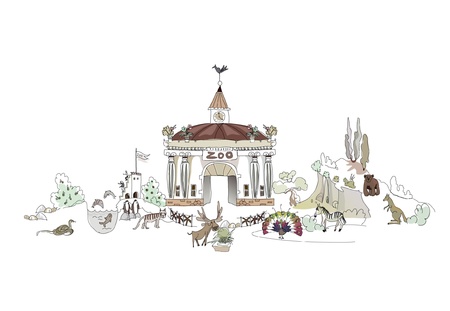
The Art of Zoo: Exploring the Fascinating World of Animal Art
The universe of craftsmanship is a huge and different one, enveloping different structures and mediums that have been utilized to communicate human innovativeness and creative mind. Notwithstanding, there is one more part of workmanship that frequently slips through the cracks – the craftsmanship made by creatures. Indeed, you read that right. Creatures have been making workmanship for quite a long time, and their manifestations are similarly as hypnotizing and interesting as those made by people. This special type of craftsmanship is known as “zoo workmanship” or “creature workmanship,” and it has earned critical respect lately. In this blog entry, we will dive into the entrancing universe of zoo workmanship and investigate its set of experiences, methods, and importance.
1. The Origins of Zoo Art
The idea of zoo craftsmanship can be followed back to antiquated times when people initially began to train creatures. It was accepted that creatures had an otherworldly association with nature and could speak with the divine beings. Thus, individuals started to notice and concentrate on creature conduct, which prompted the revelation of their imaginative capacities. For example, elephants were prepared to paint in Thailand, while chimps were educated to attract Japan. These early types of zoo craftsmanship were principally utilized for diversion purposes, yet they likewise filled in for of correspondence among people and creatures.
The Evolution of Zoo Art Techniques
After some time, zoo craftsmanship advanced and turned out to be more complex, with specialists trying different things with various procedures and mediums. Quite possibly of the most well known procedure utilized in zoo workmanship is painting with a brush held in the creature’s mouth. This strategy was first presented by a chimpanzee named Congo during the 1950s, who became renowned for his theoretical compositions. Different creatures, like elephants, ponies, and even dolphins, have additionally been prepared to paint utilizing this technique.
One more method regularly utilized in zoo workmanship is finger painting, where the creature dunks its paws or fingers in paint and makes dynamic examples on a material. This method is frequently utilized by primates, for example, orangutans and gorillas, who have skillful hands and can make complicated plans.
Aside from painting, creatures have additionally been prepared to shape utilizing dirt or other moldable materials. This procedure requires an elevated degree of expertise and coordination, and it has been dominated by elephants, bears, and even octopuses. These models are frequently sold at barters and have gotten excessive costs, for certain pieces being shown in renowned workmanship exhibitions.
The Significance of Zoo Art
The meaning of zoo craftsmanship goes past diversion and oddity. It gives a novel knowledge into the personalities of creatures and their capacity to articulate their thoughts through craftsmanship. It additionally challenges our impression of what comprises workmanship and who can be viewed as a craftsman. Art of Zoo workmanship has likewise been utilized as a type of treatment for creatures, particularly those in imprisonment, assisting them with easing pressure and weariness.
2. The Controversy Surrounding Zoo Art
While zoo craftsmanship has earned fame and respect lately, it has additionally confronted analysis and contention. One of the fundamental worries raised by basic entitlements activists is the moral ramifications of preparing creatures to make workmanship. They contend that it is a type of double-dealing and conflicts with the normal way of behaving of creatures. There have likewise been situations where creatures have been abused or compelled to make workmanship despite their desire to the contrary, which has ignited shock among creature sweethearts.
The Role of Animal Welfare Organizations
To address these worries, numerous creature government assistance associations have set rules and guidelines for zoos and asylums that train creatures to make workmanship. These rules guarantee that the creatures are dealt with morally and that their prosperity isn’t compromised. For example, the Relationship of Zoos and Aquariums (AZA) has severe guidelines for creature care and government assistance, remembering the utilization of uplifting feedback procedures for preparing creatures for zoo workmanship.
The Impact of Zoo Art on Conservation
Regardless of the debate encompassing zoo craftsmanship, it has likewise assumed a critical part in protection endeavors. Numerous zoos and asylums utilize the returns from offering creature workmanship to finance protection undertakings and backing imperiled species. This assists with bringing issues to light about preservation as well as gives a maintainable type of revenue for these associations.
3. The Future of Zoo Art
As we keep on investigating the universe of zoo workmanship, it is clear that this remarkable type of craftsmanship has a promising future. With headways in innovation, specialists are currently exploring different avenues regarding new strategies and mediums, like computer generated simulation and 3D printing, to make workmanship with creatures. These developments have opened up additional opportunities for cooperation among people and creatures, prompting considerably really interesting and provocative manifestations.
The Role of Education and Awareness
Schooling and mindfulness likewise assume a vital part in store for zoo craftsmanship. By teaching the general population about the set of experiences and meaning of zoo workmanship, we can assist with dispersing any misinterpretations and advance moral practices in preparing creatures. Bringing issues to light about preservation and the effect of zoo workmanship on jeopardized species, empowering individuals to help these initiatives is likewise fundamental.
The Potential for Collaboration
One of the most intriguing possibilities for the eventual fate of zoo workmanship is the potential for cooperation among people and creatures. As we keep on getting familiar with creature conduct and insight, we can foster better approaches for imparting and cooperating to make craftsmanship. This could prompt a more profound comprehension and enthusiasm for the regular world and our place in it.
Conclusion
All in all, the craft of zoo is an entrancing and consistently developing part of the workmanship world. From its old starting points to its advanced debates, zoo craftsmanship has caught the creative mind of individuals overall and keeps on testing our impression of workmanship and imagination. As we look towards the future, advancing moral practices and bring issues to light about the meaning of zoo workmanship in protection efforts is fundamental. Thusly, we can guarantee that this exceptional type of craftsmanship proceeds to flourish and move ages to come.







